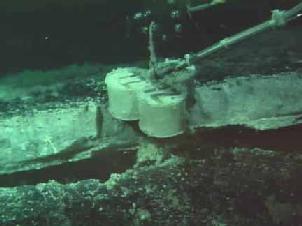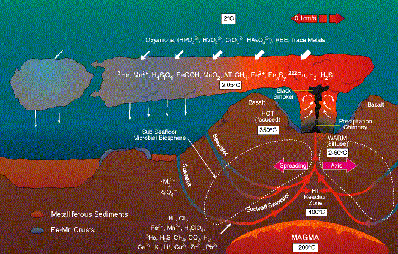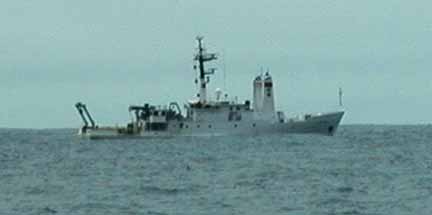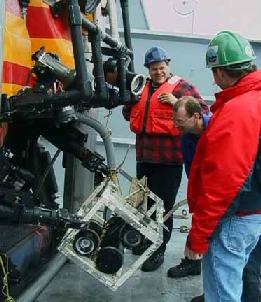WHAT'S NEW:
BACKGROUND:
Mission
Project Description
Cruise Plans:
Participants
Technology (ROV, ships, etc.)
Future Plans
Results:
1998 NeMO Cruise
Axial 1998 "Eruption"
Logbook
June 24, 1999
June 24, 1999
Contents:
- News from Thompson
- News from Wecoma
- Participant Perspective
- Logbook from Teacher at Sea
- Question/Answer from shore to sea
Thompson Science Report
Science Report - Thursday, June 24
Ships Location: 45 45.2/-130 08.3
 ROPOS returned to the Marker 33 area early today for dive 484. Bacterial
traps (right) that were left at the vent site since last summer were recovered
and new traps put in place for the next year. The bacteria that have colonized
these traps will have their DNA analyzed to find out what organisms are
living in these seafloor hot springs. An extensive biosphere of primitive
microorganisms is believed to live in high temperature environments below
the seafloor (at temperatures even above the boiling point of water at
sea level!). This deep hot biosphere is brought to the surface and made
accessible to sampling by submarine volcanic eruptions. This is a lot
of what motivates the research in the NeMO
Program - the interactions between volcanism, hydrothermal chemistry,
and biology.
ROPOS returned to the Marker 33 area early today for dive 484. Bacterial
traps (right) that were left at the vent site since last summer were recovered
and new traps put in place for the next year. The bacteria that have colonized
these traps will have their DNA analyzed to find out what organisms are
living in these seafloor hot springs. An extensive biosphere of primitive
microorganisms is believed to live in high temperature environments below
the seafloor (at temperatures even above the boiling point of water at
sea level!). This deep hot biosphere is brought to the surface and made
accessible to sampling by submarine volcanic eruptions. This is a lot
of what motivates the research in the NeMO
Program - the interactions between volcanism, hydrothermal chemistry,
and biology.
ROPOS also visited Cloud
vent for the first time this trip and found that it was also still
vigorously venting and had been much more extensively colonized by vent
animals than we saw last summer (including scale worms, tubeworms, and
the new species of scale worm discovered last year).  In fact, there were so many scale worms (left) around Cloud vent that
it looked like the lava rocks had chickenpox! At the end of the dive
the time-lapse camera that had been at Marker 33 for a year was recovered,
and all signs suggest that it worked (though the film will not be developed
until after the cruise). Our visits to Marker 33 and Cloud vent are very
encouraging because they show that the venting in the 1998 lava flow
has not diminished significantly, and yet many changes have taken place
since last year. The story that is unfolding is an interesting one,
but we are only at the beginning - there should be many more details to
come.
In fact, there were so many scale worms (left) around Cloud vent that
it looked like the lava rocks had chickenpox! At the end of the dive
the time-lapse camera that had been at Marker 33 for a year was recovered,
and all signs suggest that it worked (though the film will not be developed
until after the cruise). Our visits to Marker 33 and Cloud vent are very
encouraging because they show that the venting in the 1998 lava flow
has not diminished significantly, and yet many changes have taken place
since last year. The story that is unfolding is an interesting one,
but we are only at the beginning - there should be many more details to
come.
Wecoma Science Report
After a week of solid work here at Axial we have a good idea of the sources and fate of the hydrothermal venting initiated by the 1998 eruption. As in the summer of 1998, the principal venting source remains the new lava field, with a minor contribution from the long-lasting ASHES site. Both the optical and temperature intensity of the plume are comparable to that found last year, indicating little decline in the hydrothermal activity. The horizontal extent of the plume is also similar to 1998. Thus the NeMO site appears headed for a long period of substantial discharge. This trend is in sharp contrast to the previous two eruptions, at CoAxial and Gorda Ridge, both of which experienced a significant decline after 18 months.
Our plume mapping and sampling has defined a narrow and intense plume being advected primarily to the southwest, out of the open end of the caldera. The plume bends around the caldera and streams to the west, with the core only a few km wide. We suspect that the currents are being steered by the bathymetry. The current records for last year that we recovered on this cruise will let us test that hypothesis, and should provide a basis for a good estimate of the heat and chemical flux from the new eruption site.
In addition to the plume work, we have successfully recovered all 9 moorings from last year, and deployed 6 new ones in their place. The Thomas Thompson will deploy our other 3 moorings after their work with ROPOS is completed. New this year on the moorings are 14 optical-temperature sensors--"mini MAPRs" that will monitor the plume more clearly than can temperature alone. Also new on the moorings are 2 "osmosamplers" built by researchers from MBARI. They will continuously sample plume waters into very small diameter tubes, which will be analyzed after recovery next year.

(image shows cumulation of plume studies at Cleft from 1986-97)
We have about 2 more day's work here, after which we will proceed
south to the
Cleft segment for 3 days to continue our 15 yr time series at
those venting sites. Everyone on board has been working very long hours
and accomplishing more than they anticipated.
That's the news from Wecoma. We'll arrive in Newport the morning of the 29th. Cheers, Ed Baker
Listing of all Science News postings
Life at Sea: Participant Perspective
Kevin Roe
NOAA Vents Program
 My name is Kevin
Roe and I work out of NOAA/PMEL in Seattle. I'm on my fifth research cruise
since last June, all of which are either manned or unmanned submersible
cruises. I went on my first research cruise 21 years ago. This was only
one year after the first hydrothermal vents were discovered and I am only
in mid-career. I came to NOAA/PMEL in late 1984 with the expressed interest
to help in the study of the chemistry
of hydrothermal vent fluids and hydrothermal plume chemistry. Dreams
do come true!
My name is Kevin
Roe and I work out of NOAA/PMEL in Seattle. I'm on my fifth research cruise
since last June, all of which are either manned or unmanned submersible
cruises. I went on my first research cruise 21 years ago. This was only
one year after the first hydrothermal vents were discovered and I am only
in mid-career. I came to NOAA/PMEL in late 1984 with the expressed interest
to help in the study of the chemistry
of hydrothermal vent fluids and hydrothermal plume chemistry. Dreams
do come true!
Hydrothermal vent fluids can range in temperature from slightly above
bottom seawater temperature (>2o C-60oC) also called diffuse venting,
to high temperature vent fluids with a maximum temperature slightly
above 400o C. My job on board is to first analyze vent fluids for
dissolved chemicals that are best analyzed immediately, such as ammonia,
hydrogen sulfide, silica and measure pH quickly before oxidation,

(click for full size)
precipitation, bacterial utilization or simple degassing occur. Secondly,
I take samples that can be preserved for analyzes back at the lab. I then
analyze dissolve metals such as iron, manganese, zinc, copper, cadmium,
silver, and lead and major ions such as sodium, chloride, magnesium,
sulfate, calcium, strontium, potassium, borate, and trace elements. I
have to use a variety of techniques and I'm doing some of my data
reduction from laboratory analyzes in my spare time aboard the ship.
What is done with all this data? Microbiologists and biologists need to know the sulfide concentrations as sulfide is one of the "fuels" of the vent community ecosystem. Sulfide, pH, iron and major ions change with time when a volcanic event occurs and analysis of these components over time give a clue to the evolution of the heat source and the future of the local biological community. If the hydrothermal fluid encounters sediment before venting, high concentrations of ammonia and boron are measured in the vent fluids. If vent fluids are less "salty" than seawater, phase separation (boiling) has occurred and this gives a clue to the depth and temperature of the heat source.
To date, it has been a little slow as the fluid sampler has not been put to use. Once we begin to get vent fluids, I'll be very busy, sometimes working for 24 hours straight as do many of us on board. When you helping to solve a mystery, you lose track of time.
Listing of all Perspectives postings
Teacher At Sea Logbook
Day 9, Thursday 6/24/99
A majority of my day focused on our ship, the Wecoma. The name Wecoma means "sea" in the language of the Northwest Native American Chinook tribe. This name is certainly appropriate considering the role of the ship in our research program at NeMO (The New millenium Observatory).
 Photo of Wecoma taken from R/V Thompson at Axial Volcano, 1999. |
The deck on the fantail has numerous boltdowns to secure scientific equipment for travel from one location to the next station or research area. It is a great place to enjoy the view of the open ocean. Just wear a jacket!
A Marine Technician is assigned to the ship for each cruise to coordinate scientific operations with the scientists. Daryl Swensen is our well-trained support. He is always prepared and ready to answer any of my questions.
There are a variety of winches aboard - hydrographic, trawl, deepsea traction as well as others. These winches have spooled wire for mooring recovery and deployments. They make a great deal of noise when operating.
My stateroom (bedroom) is shared with Sharon Walker, oceanographer, NOAA/PMEL and Rachel Shackelford, University of Hawaii graduate student. I have a bottom bunk on the starboard (right) side. We are lucky to have a head (restroom) and shower inside our stateroom. It is cozy but with plenty of space for the amount of time spent in it. My watch is from 8am - 12pm, and 20:00 - 00:00 (8pm- 12am) each day. But I am usually around the lab or on the fantail more than that - I don't want to miss anything.
Join me tomorrow so you don't miss anything.
Fair seas,
Ms. Deck
Teacher Log #5 6/24/99
Dive 484 started with high hopes but was faced with many obstacles. The plan was to complete the objectives of yesterdays Dive 483, collect additional biological samples at Cloud Vent, and finish with a test run of the Imagenex sonar mapping system. Unfortunately, increasing winds and swell size and a poorly functioning bow-thruster, one of the three used to maintain the ships position during dives, caused the dive to end early.
After making a few collections of specimens and microbial traps,  ROPOS went about the task of mapping the area known as Marker 33, a well-studied
active vent site. An attempt to survey Marker 33 with the Imagenex was
postponed due to the temporary problem with the bow-thruster. On the way
back to the cage, ROPOS was positioned to retrieve a time-lapse camera
deployed during the 1998 cruise. This is when the real excitement began.
After positioning the camera so that ROPOS could grab it with both arms,
difficulty began when the detachable weight (used for ballast) on the
ROV would not release. While the pilot began dragging the weights in an
attempt to detach them, an alarm sounded indicating little to no hydraulic
oil registered and the system was failing. After restarting the system,
the motor on ROPOS refused to restart. Everything had come to a stop.
Well you dont send down an extremely important research vessel to the
bottom of the ocean without a few fail safe systems. The pilot and support
technicians directed the cage to begin slowly pulling ROPOS back to it
using the tether cable that connects the ROV to the cage. After bringing
ROPOS to within 40 m of it, the winch on board the Thompson began the
slow process of bringing both units to the surface. As the cage and ROV
got closer to the surface they were able to restart the motor of ROPOS
(remember it is used under extreme pressure and that may have prevented
it from starting earlier). ROPOS was then positioned in the cage as normal
and brought safely back on deck. (photo right)
ROPOS went about the task of mapping the area known as Marker 33, a well-studied
active vent site. An attempt to survey Marker 33 with the Imagenex was
postponed due to the temporary problem with the bow-thruster. On the way
back to the cage, ROPOS was positioned to retrieve a time-lapse camera
deployed during the 1998 cruise. This is when the real excitement began.
After positioning the camera so that ROPOS could grab it with both arms,
difficulty began when the detachable weight (used for ballast) on the
ROV would not release. While the pilot began dragging the weights in an
attempt to detach them, an alarm sounded indicating little to no hydraulic
oil registered and the system was failing. After restarting the system,
the motor on ROPOS refused to restart. Everything had come to a stop.
Well you dont send down an extremely important research vessel to the
bottom of the ocean without a few fail safe systems. The pilot and support
technicians directed the cage to begin slowly pulling ROPOS back to it
using the tether cable that connects the ROV to the cage. After bringing
ROPOS to within 40 m of it, the winch on board the Thompson began the
slow process of bringing both units to the surface. As the cage and ROV
got closer to the surface they were able to restart the motor of ROPOS
(remember it is used under extreme pressure and that may have prevented
it from starting earlier). ROPOS was then positioned in the cage as normal
and brought safely back on deck. (photo right)
The day was not without its triumphs. The time-lapse camera was successfully brought to the surface, the film is being retrieved, and the instrument cleaned and prepared for deployment at the bottom again. This camera was placed by ROPOS a year ago under the watchful eye of Dr. Verena Tunnicliffe of the University of Victoria. The goal was for the camera to document the sequence of biological changes in a specific location along a new vent. It is hopeful that the pictures will show how a vent ecosystem changes over a period of time. Some 225 frames of film were shot by the camera over the 10 months it has been down there. This is just one of the ways scientists can extend their visiting time on the bottom without actually have to be on site.
 On the lighter
side of the more intense happenings of the day was the great crab capture
(left). Crabs in these extreme ecosystems are believed to be the top carnivores.
In order to determine the flow of nutrients through this system, the capture
and analysis of these hard to come by species is a must. After a spirited
chase, escape, and chase again, ROPOS and the pilot were able to capture
one of these critters. One crab was initially placed in the biobox and
as soon as it saw a slim avenue of escape, took advantage of the opportunity.
But fortunately another crab was located and was successfully collected.
Crab salad was not on the menu in the mess tonight. This particular specimen
smelled bad due the hydrogen sulfide from the vent environment.
On the lighter
side of the more intense happenings of the day was the great crab capture
(left). Crabs in these extreme ecosystems are believed to be the top carnivores.
In order to determine the flow of nutrients through this system, the capture
and analysis of these hard to come by species is a must. After a spirited
chase, escape, and chase again, ROPOS and the pilot were able to capture
one of these critters. One crab was initially placed in the biobox and
as soon as it saw a slim avenue of escape, took advantage of the opportunity.
But fortunately another crab was located and was successfully collected.
Crab salad was not on the menu in the mess tonight. This particular specimen
smelled bad due the hydrogen sulfide from the vent environment.
Dive 484 is now in the books and on tape, ROPOS is being configured for Dive 485. We are hopeful that the problems that developed earlier today will soon be fixed and that the much anticipated vent fluid sampler will be put into action. On a side note, there is a rumor about an abducted plastic "honey bear" being the jinx aboard the Thompson and causing all the problems with ROPOS. Well keep you posted on this development. Bye for now.
Logbook of all Teacher At Sea postings
Questions & Answers
(oar.pmel.vents.webmaster@noaa.gov)